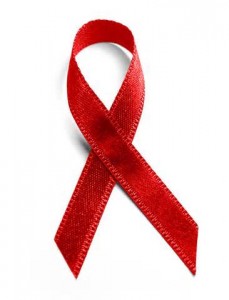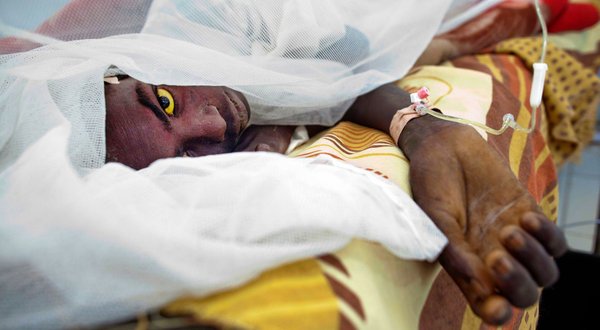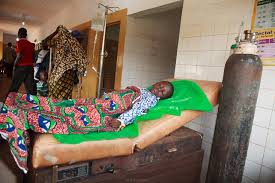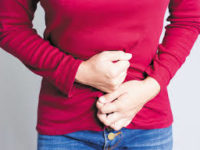In 1984, 3 years after the first reports of a disease that was to become known as AIDS, researchers discovered the primary causative viral agent, the human immunodeficiency virus type 1 (HIV-1). In 1986, a second type of HIV, called HIV-2, was isolated from AIDS patients in West Africa, where it may have been present decades earlier.
Studies of the natural history of HIV-2 are limited, but to date comparisons with HIV-1 show some similarities while suggesting differences. Both HIV-1 and HIV-2 have the same modes of transmission and are associated with similar opportunistic infections and AIDS. In persons infected with HIV-2, immunodeficiency seems to develop more slowly and to be milder. Compared with persons infected with HIV-1, those with HIV-2 are less infectious early in the course of infection. As the disease advances, HIV-2 infectiousness seems to increase; however, compared with HIV-1, the duration of this increased infectiousness is shorter. HIV-1 and HIV-2 also differ in geographic patterns of infection; the United States has few reported cases.
Which countries have a high prevalence* of HIV-2 infection?
HIV-2 infections are predominantly found in Africa. West African nations with a prevalence of HIV-2 of more than 1% in the general population are Cape Verde, Côte d’Ivoire (Ivory Coast), Gambia, Guinea-Bissau, Mali, Mauritania, Nigeria, and Sierra Leone. Other West African countries reporting HIV-2 are Benin, Burkina Faso, Ghana, Guinea, Liberia, Niger, São Tomé, Senegal, and Togo. Angola and Mozambique are other African nations where the prevalence of HIV-2 is more than 1%.
*Prevalence is the proportion of cases present in a population at a given point in time.
What is known about HIV-2 in the United States?
HIV-2 infections are predominantly found in Africa. West African nations with a prevalence of HIV-2 of more than 1% in the general population are Cape Verde, Côte d’Ivoire (Ivory Coast), Gambia, Guinea-Bissau, Mali, Mauritania, Nigeria, and Sierra Leone. Other West African countries reporting HIV-2 are Benin, Burkina Faso, Ghana, Guinea, Liberia, Niger, São Tomé, Senegal, and Togo. Angola and Mozambique are other African nations where the prevalence of HIV-2 is more than 1%.
*Prevalence is the proportion of cases present in a population at a given point in time.
What is known about HIV-2 in the United States?
 The first case of HIV-2 infection in the United States was diagnosed in 1987. Since then, the Centers for Disease Control and Prevention (CDC) has worked with state and local health departments to collect demographic, clinical, and laboratory data on persons with HIV-2 infection.
The first case of HIV-2 infection in the United States was diagnosed in 1987. Since then, the Centers for Disease Control and Prevention (CDC) has worked with state and local health departments to collect demographic, clinical, and laboratory data on persons with HIV-2 infection.
Of the 79 infected persons, 66 are black and 51 are male. Fifty-two were born in West Africa, 1 in Kenya, 7 in the United States, 2 in India, and 2 in Europe. The region of origin was not known for 15 of the persons, although 4 of them had a malaria-antibody profile consistent with residence in West Africa. AIDS-defining conditions have developed in 17, and 8 have died.
These case counts represent minimal estimates because completeness of reporting has not been assessed. Although AIDS is reported uniformly nationwide, the reporting of HIV infection, including HIV-2 infection, differs from state to state according to state policy.
Who should be tested for HIV-2?
Because epidemiologic data indicate that the prevalence of HIV-2 in the United States is very low, CDC does not recommend routine HIV-2 testing at U.S. HIV counseling and test sites or in settings other than blood centers. However, when HIV testing is to be performed, tests for antibodies to both HIV-1 and HIV-2 should be obtained if demographic or behavioral information suggests that HIV-2 infection might be present.
Persons at risk for HIV-2 infection include
Sex partners of a person from a country where HIV-2 is endemic (refer to countries listed earlier)
Sex partners of a person known to be infected with HIV-2
People who received a blood transfusion or a nonsterile injection in a country where HIV-2 is endemic
People who shared needles with a person from a country where HIV-2 is endemic or with a person known to be infected with HIV-2
Children of women who have risk factors for HIV-2 infection or are known to be infected with HIV-2
HIV-2 testing also is indicated for
People with an illness that suggests HIV infection (such as an HIV-associated opportunistic infection) but whose HIV-1 test result is not positive
People for whom HIV-1 Western blot exhibits the unusual indeterminate test band pattern of gag (p55, p24, or p17) plus pol (p66, p51, or p32) in the absence of env (gp160, gp120, or gp41)
Among all HIV-infected people, the prevalence of HIV-2 is very low compared with HIV-1. However, the potential risk for HIV-2 infection in some populations (such as those listed) may justify routine HIV-2 testing for all people for whom HIV-1 testing is warranted. The decision to implement routine HIV-2 testing requires consideration of the number of HIV-2-infected persons whose infection would remain undiagnosed without routine HIV-2 testing compared with the problems and costs associated with the implementation of HIV-2 testing.
The development of antibodies is similar in HIV-1 and HIV-2. Antibodies generally become detectable within 3 months of infection. Testing for HIV-2 antibodies is available through private physicians or state and local health departments.
Are blood donors tested for HIV-2?
Since 1992, all U.S. blood donations have been tested with a combination HIV-1/HIV-2 enzyme immunoassay test kit that is sensitive to antibodies to both viruses. This testing has demonstrated that HIV-2 infection in blood donors is extremely rare. All donations detected with either HIV-1 or HIV-2 are excluded from any clinical use, and donors are deferred from further donations.
Is the clinical treatment of HIV-2 different from that of HIV-1?
Little is known about the best approach to the clinical treatment and care of patients infected with HIV-2. Given the slower development of immunodeficiency and the limited clinical experience with HIV-2, it is unclear whether antiretroviral therapy significantly slows progression. Not all of the drugs used to treat HIV-1 infection are as effective against HIV-2. In vitro (laboratory) studies suggest that nucleoside analogs are active against HIV-2, though not as active as against HIV-1. Protease inhibitors should be active against HIV-2. However, non-nucleoside reverse transcriptase inhibitors (NNRTIs) are not active against HIV-2. Whether any potential benefits would outweigh the possible adverse effects of treatment is unknown.
Monitoring the treatment response of patients infected with HIV-2 is more difficult than monitoring people infected with HIV-1. No FDA-licensed HIV-2 viral load assay is available yet. Viral load assays used for HIV-1 are not reliable for monitoring HIV-2. Response to treatment for HIV-2 infection may be monitored by following CD4+ T-cell counts and other indicators of immune system deterioration, such as weight loss, oral candidiasis, unexplained fever, and the appearance of a new AIDS-defining illness. More research and clinical experience is needed to determine the most effective treatment for HIV-2.
The optimal timing for antiretroviral therapy (i.e., soon after infection, when symptoms appear, or when CD4+ T cell counts fall below a certain level) remains under review by clinical experts. Guidelines for the Use of Antiretroviral Agents in HIV-Infected Adults and Adolescents, by the Department of Health and Human Services Panel on Clinical Practices for Treatment of HIV Infection, may be helpful to the clinician who is caring for a patient infected with HIV-2; however, the recommendations on viral load monitoring and the use of NNRTIs would not apply to patients with HIV-2 infection. Copies of the guidelines are available from the CDC National Prevention Information Network (1 800 458-5231) and from its Web site (www.cdcnpin.org). The guidelines also are available from the HIV/AIDS Treatment Information Service (1 800 448-0440; Fax 301 519-6616; TTY 1 800 243-7012) and on the ATIS Web site (www.hivatis.org).
What is known about HIV-2 infection in children?
HIV-2 infection in children is rare. Compared with HIV-1, HIV-2 seems to be less transmissible from an infected mother to her child. However, cases of transmission from an infected woman to her fetus or newborn have been reported among women who had primary HIV-2 infection during their pregnancy. Zidovudine therapy has been demonstrated to reduce the risk for perinatal HIV-1 transmission and also might prove effective for reducing perinatal HIV-2 transmission. Zidovudine therapy should be considered for HIV-2-infected expectant mothers and their newborns, especially for women who become infected during pregnancy.
How should physicians and patients decide whether to start treatment for HIV-2?
Physicians caring for patients with HIV-2 infection should decide whether to initiate antiretroviral therapy after discussing with their patients what is known, what is not known, and the possible adverse effects of treatment.
What can be done to control the spread of HIV-2?
Continued surveillance is needed to monitor HIV-2 in the U.S. population because the possibility for further spread of HIV-2 exists, especially among injecting drug users and people with multiple sex partners. Programs aimed at preventing the transmission of HIV-1 also can help to prevent and control the spread of HIV-2.





